Related Research Articles
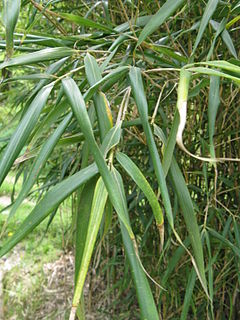
Pleioblastus is an East Asian genus of monopodial bamboos in the grass family Poaceae. They are native to China and Japan, and naturalized in scattered places in Korea, Europe, New Zealand, and the Western Hemisphere.

Kalanchoe, or kal-un-KOH-ee, or kal-un-kee, also written Kalanchöe or Kalanchoë, is a genus of about 125 species of tropical, succulent flowering plants in the family Crassulaceae, mainly native to Madagascar and tropical Africa. Kalanchoe was one of the first plants to be sent into space, sent on a resupply to the Soviet Salyut 1 space station in 1979.

Casuarina is a genus of 17 tree species in the family Casuarinaceae, native to Australia, the Indian subcontinent, southeast Asia, islands of the western Pacific Ocean, and eastern Africa. It was once treated as the sole genus in the family, but has been split into four genera.

Chamaerops is a genus of flowering plants in the family Arecaceae. The only currently fully accepted species is Chamaerops humilis, variously called European fan palm or the Mediterranean dwarf palm. It is one of the most cold-hardy palms and is used in landscaping in temperate climates.

Ruellia humilis is a species of flowering plant in the family Acanthaceae. It is native to the eastern United States. It is grown as an ornamental plant.
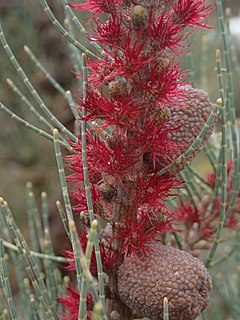
Allocasuarina humilis, commonly known as the dwarf sheoak or dwarf casuarina, is a woody shrub of the family Casuarinaceae endemic to the south-west of Western Australia.
Cycladenia humilis is the sole member of the monotypic genus Cycladenia. Known by the common name Sacramento waxydogbane, it is an uncommon plant native to the southwestern United States. Collections have mostly been from California, although the species has also been reported from Utah and Arizona, mostly on gypsum soils. It is found at some elevation in several mountain ranges in the region. One of the four varieties of this plant, called the Jones waxydogbane, is considered a threatened taxon. This is a fleshy perennial herb with dull green leaves and pinkish lavender flowers. The flowers begin as rolled tubes shaped like pea pods and then open into colorful funnel-shaped blooms.
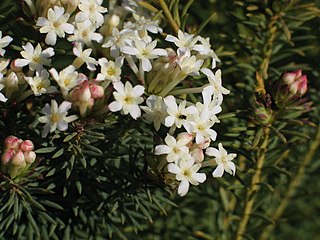
Gnidia is a genus of flowering plants in the family Thymelaeaceae. It is distributed in Africa, Madagascar, Arabia, India, and Sri Lanka; more than half of all the species are endemic to South Africa. Gnidia was named for Knidos, an Ancient Greek city located in modern-day Turkey.

The Palmetum is a specialized botanical garden located in the Malakpet area, Hyderabad, in Telangana, which features only one family of plant: the palm.
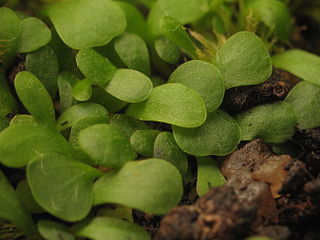
Utricularia livida, the leaden bladderwort, is a species of flowering plant in the bladderwort family, native to central and southern Africa, and Mexico. Growing to 50 cm (20 in) tall and broad, it is a carnivorous perennial. It was originally described and published by Ernst Heinrich Friedrich Meyer in 1837.
Psiadiella is a genus of Madagascarian plants in the aster tribe within the daisy family.
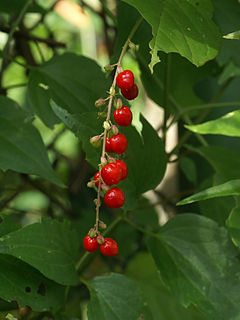
Rivina humilis is a species of flowering plant in the family Petiveriaceae. It was formerly placed in the pokeweed family, Phytolaccaceae. It can be found in the southern United States, the Caribbean, Central America, and tropical South America. Common names include pigeonberry, rougeplant, baby peppers, bloodberry, and coralito. The specific epithet means "dwarfish" or "lowly" in Latin, referring to the plant's short stature.
Dypsis humilis is a rare species of stemless palm that was discovered in Madagascar in 2007 by a collaboration between botanists from Madagascar and Royal Botanical Gardens, Kew. Fewer than ten plants were observed in an area that is threatened by logging and other human activity.

The North-West University Botanical Garden on the Potchefstroom Campus of the North-West University (NWU) is the only botanical garden in the North West Province of South Africa. The Garden spans just under three hectares and is open to the public.
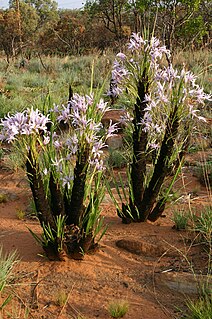
Xerophyta is a plant genus in the family Velloziaceae erected in 1789. It is native to Africa, Madagascar, and the Arabian Peninsula.
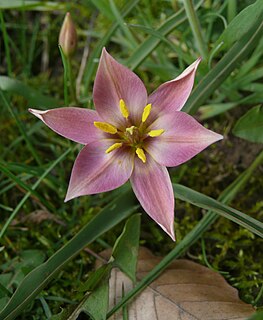
Tulipa humilis is a species of flowering plant in the lily family, found in Syria, Lebanon, Israel, Turkey, Iran, and the North Caucasus region of Russia. The flowers are pink with yellow centers. Its preferred habitat are rocky mountain slopes. It is known by several other names in horticulture.

Octotropideae is a tribe of flowering plants in the family Rubiaceae and contains about 103 species in 18 genera. Its representatives are found in the paleotropics.

Goodenia humilis, commonly known as swamp goodenia, is a species of flowering plant in the family Goodeniaceae and is endemic to south-eastern Australia. It is a weak, perennial herb with linear to lance-shaped leaves mostly at the base of the plant, and racemes or thyrses of yellow or yellowish-brown flowers.
References
- 1 2 Michel Guédès. 1975. Phyton, Annales rei Botanicae, Horn (Austria) 17(1–2): 134–135, fig. 1–10.
- ↑ Kew World Checklist of Selected Plant Families